tire type TOYOTA HIGHLANDER HYBRID 2020 Warranties & Maintenance Guides (in English)
[x] Cancel search | Manufacturer: TOYOTA, Model Year: 2020, Model line: HIGHLANDER HYBRID, Model: TOYOTA HIGHLANDER HYBRID 2020Pages: 260, PDF Size: 8.54 MB
Page 203 of 260
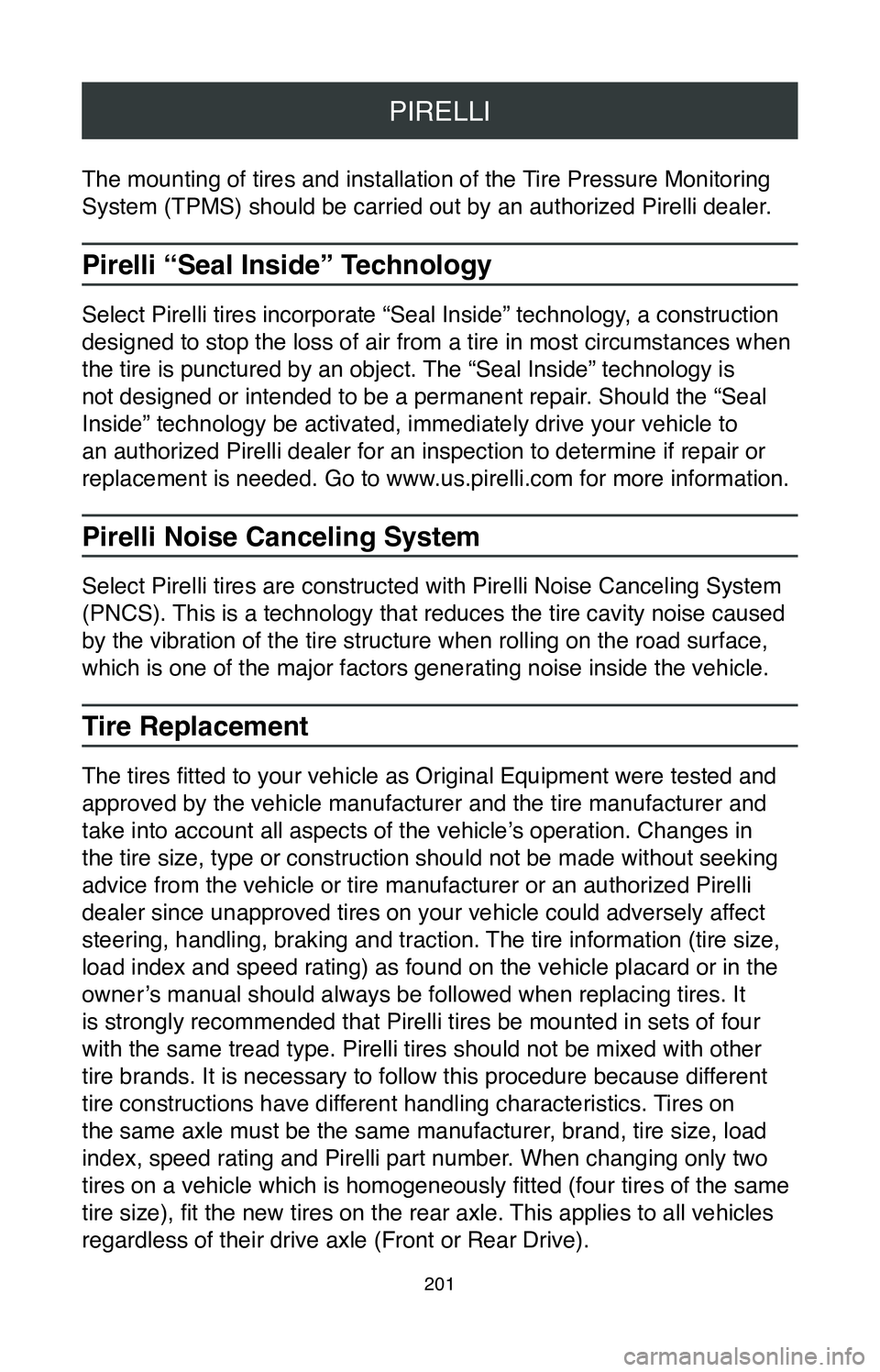
PIRELLI
201
The mounting of tires and installation of the Tire Pressure Monitoring
System (TPMS) should be carried out by an authorized Pirelli dealer.
Pirelli “Seal Inside” Technology
Select Pirelli tires incorporate “Seal Inside” technology, a construction
designed to stop the loss of air from a tire in most circumstances when \
the tire is punctured by an object. The “Seal Inside” technology is
not designed or intended to be a permanent repair. Should the “Seal
Inside” technology be activated, immediately drive your vehicle to
an authorized Pirelli dealer for an inspection to determine if repair or\
replacement is needed. Go to www.us.pirelli.com for more information.
Pirelli Noise Canceling System
Select Pirelli tires are constructed with Pirelli Noise Canceling System\
(PNCS). This is a technology that reduces the tire cavity noise caused
by the vibration of the tire structure when rolling on the road surface,\
which is one of the major factors generating noise inside the vehicle.
Tire Replacement
The tires fitted to your vehicle as Original Equipment were tested and
approved by the vehicle manufacturer and the tire manufacturer and
take into account all aspects of the vehicle’s operation. Changes in
the tire size, type or construction should not be made without seeking
advice from the vehicle or tire manufacturer or an authorized Pirelli
dealer since unapproved tires on your vehicle could adversely affect
steering, handling, braking and traction. The tire information (tire size,
load index and speed rating) as found on the vehicle placard or in the \
owner’s manual should always be followed when replacing tires. It
is strongly recommended that Pirelli tires be mounted in sets of four
with the same tread type. Pirelli tires should not be mixed with other
tire brands. It is necessary to follow this procedure because different
tire constructions have different handling characteristics. Tires on
the same axle must be the same manufacturer, brand, tire size, load
index, speed rating and Pirelli part number. When changing only two
tires on a vehicle which is homogeneously fitted (four tires of the same
tire size), fit the new tires on the rear axle. This applies to all vehicles
regardless of their drive axle (Front or Rear Drive).
Page 206 of 260
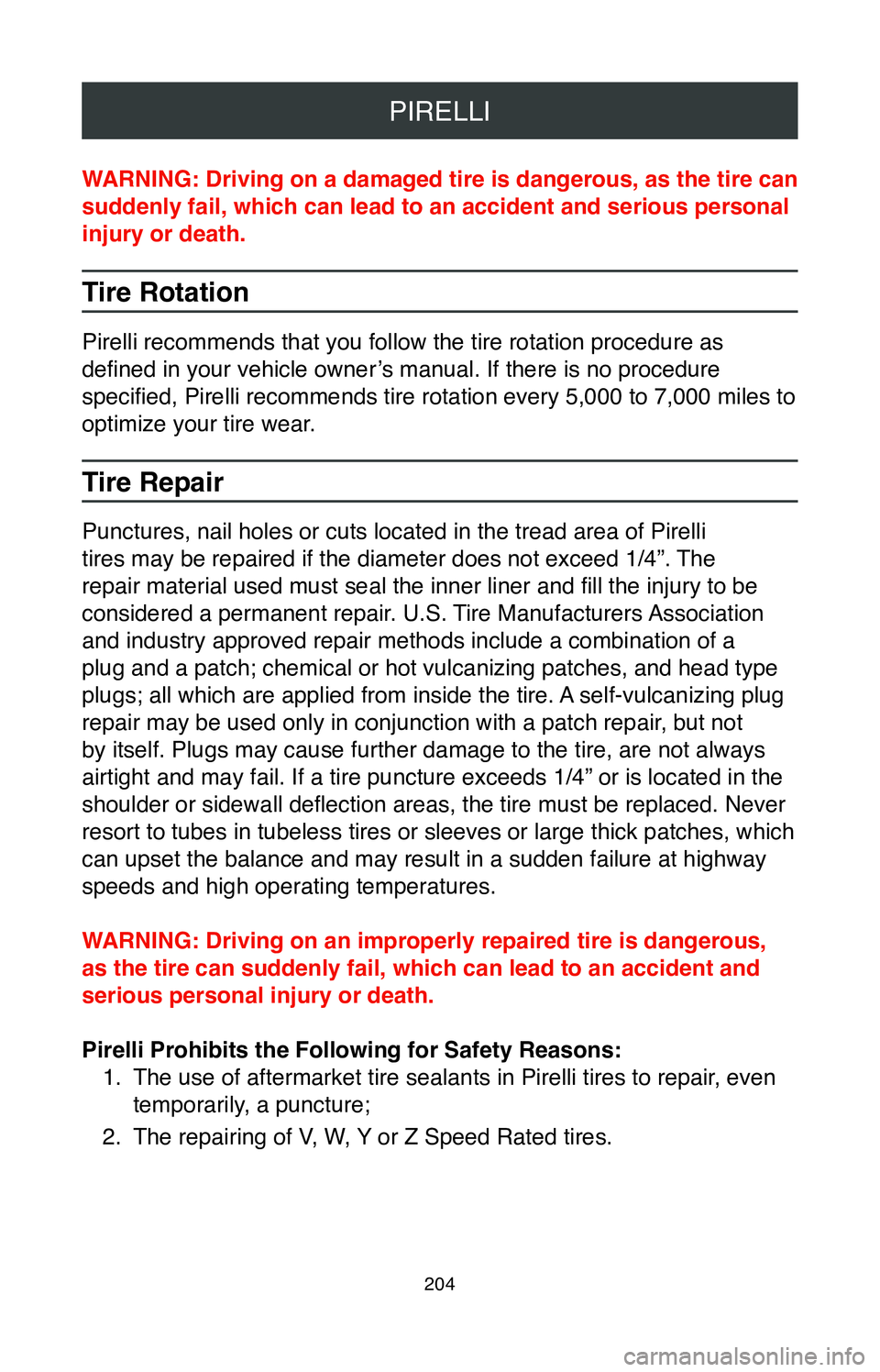
PIRELLI
204
WARNING: Driving on a damaged tire is dangerous, as the tire can
suddenly fail, which can lead to an accident and serious personal
injury or death.
Tire Rotation
Pirelli recommends that you follow the tire rotation procedure as
defined in your vehicle owner’s manual. If there is no procedure
specified, Pirelli recommends tire rotation every 5,000 to 7,000 miles to
optimize your tire wear.
Tire Repair
Punctures, nail holes or cuts located in the tread area of Pirelli
tires may be repaired if the diameter does not exceed 1/4”. The
repair material used must seal the inner liner and fill the injury to be
considered a permanent repair. U.S. Tire Manufacturers Association
and industry approved repair methods include a combination of a
plug and a patch; chemical or hot vulcanizing patches, and head type
plugs; all which are applied from inside the tire. A self-vulcanizing plug
repair may be used only in conjunction with a patch repair, but not
by itself. Plugs may cause further damage to the tire, are not always
airtight and may fail. If a tire puncture exceeds 1/4” or is located \
in the
shoulder or sidewall deflection areas, the tire must be replaced. Never
resort to tubes in tubeless tires or sleeves or large thick patches, whi\
ch
can upset the balance and may result in a sudden failure at highway
speeds and high operating temperatures.
WARNING: Driving on an improperly repaired tire is dangerous,
as the tire can suddenly fail, which can lead to an accident and
serious personal injury or death.
Pirelli Prohibits the Following for Safety Reasons:1.
The use of aftermarket tire sealants in Pirelli tires to repair, even
temporarily, a puncture;
2.
The repairing of V, W, Y or Z Speed Rated tires.
Page 207 of 260
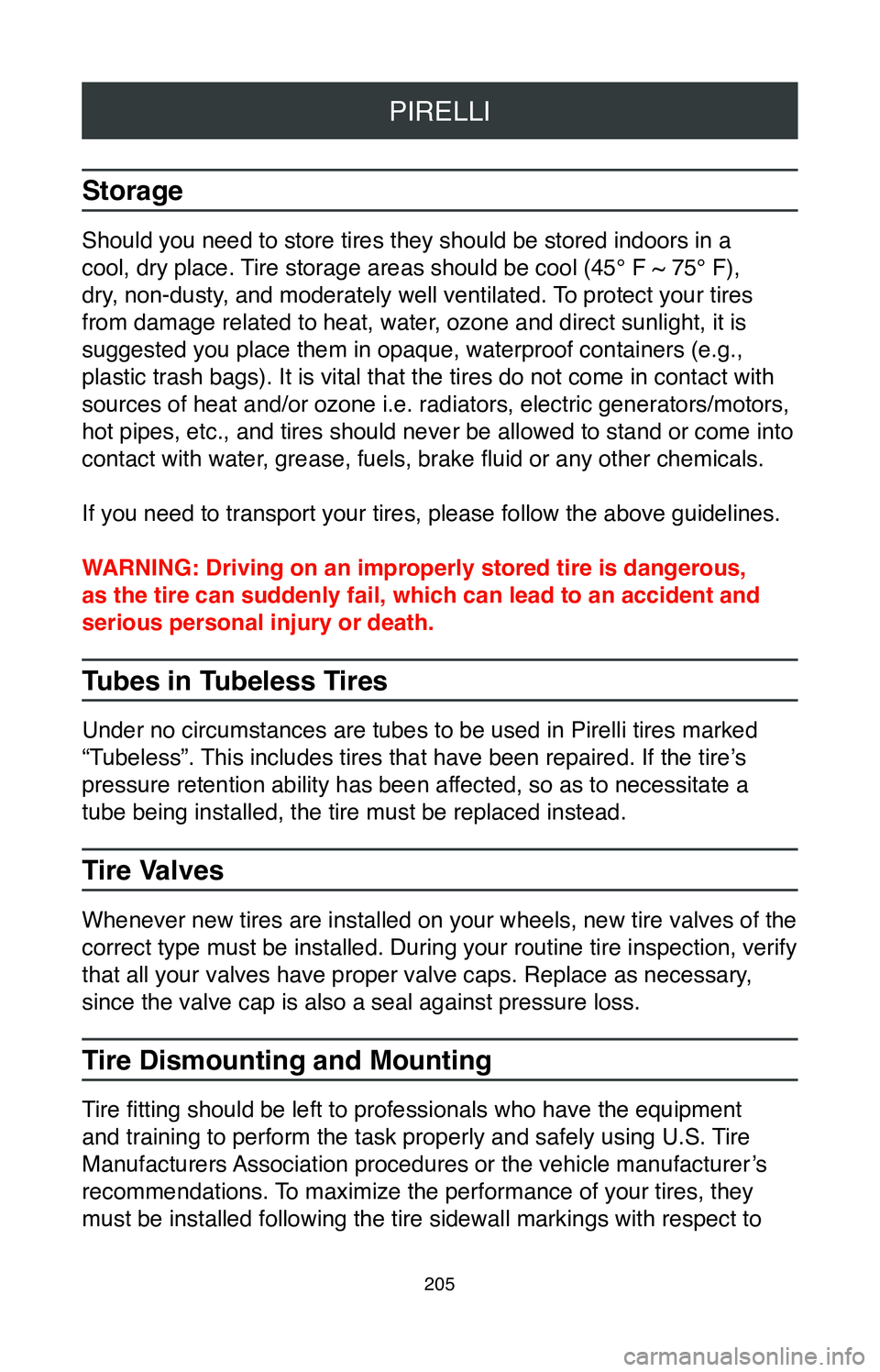
PIRELLI
205
Storage
Should you need to store tires they should be stored indoors in a
cool, dry place. Tire storage areas should be cool (45° F ~ 75° F),
dry, non-dusty, and moderately well ventilated. To protect your tires
from damage related to heat, water, ozone and direct sunlight, it is
suggested you place them in opaque, waterproof containers (e.g.,
plastic trash bags). It is vital that the tires do not come in contact \
with
sources of heat and/or ozone i.e. radiators, electric generators/motors,\
hot pipes, etc., and tires should never be allowed to stand or come into\
contact with water, grease, fuels, brake fluid or any other chemicals.
If you need to transport your tires, please follow the above guidelines.\
WARNING: Driving on an improperly stored tire is dangerous,
as the tire can suddenly fail, which can lead to an accident and
serious personal injury or death.
Tubes in Tubeless Tires
Under no circumstances are tubes to be used in Pirelli tires marked
“Tubeless”. This includes tires that have been repaired. If the tire’s
pressure retention ability has been affected, so as to necessitate a
tube being installed, the tire must be replaced instead.
Tire Valves
Whenever new tires are installed on your wheels, new tire valves of the \
correct type must be installed. During your routine tire inspection, ver\
ify
that all your valves have proper valve caps. Replace as necessary,
since the valve cap is also a seal against pressure loss.
Tire Dismounting and Mounting
Tire fitting should be left to professionals who have the equipment
and training to perform the task properly and safely using U.S. Tire
Manufacturers Association procedures or the vehicle manufacturer’s
recommendations. To maximize the performance of your tires, they
must be installed following the tire sidewall markings with respect to
Page 222 of 260
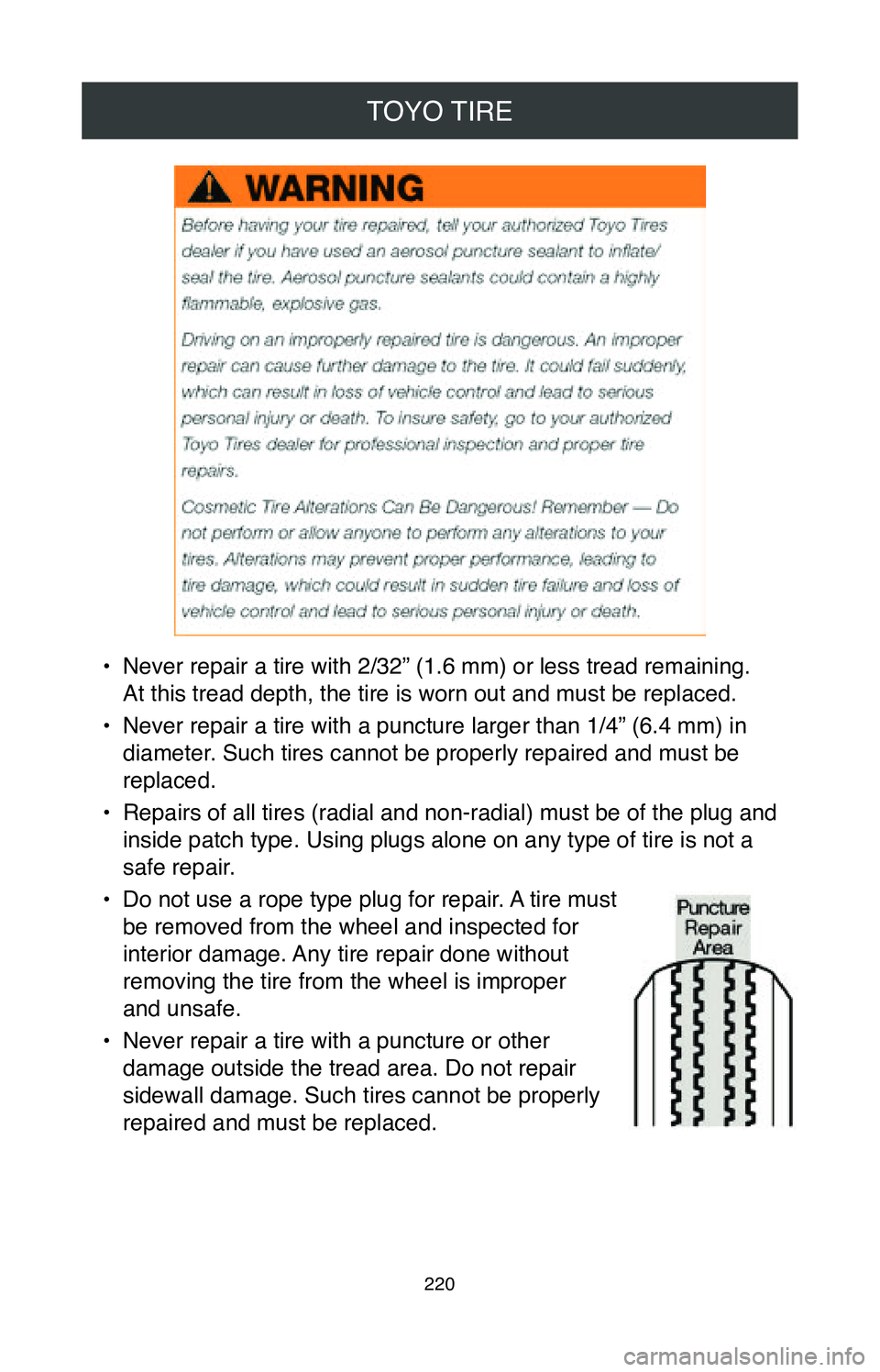
TOYO TIRE
220
• Never repair a tire with 2/32” (1.6 mm) or less tread remaining.
At this tread depth, the tire is worn out and must be replaced.
•
Never repair a tire with a puncture larger than 1/4” (6.4 mm) in
diameter. Such tires cannot be properly repaired and must be
replaced.
•
Repairs of all tires (radial and non-radial) must be of the plug and
inside patch type. Using plugs alone on any type of tire is not a
safe repair.
•
Do not use a rope type plug for repair. A tire must
be removed from the wheel and inspected for
interior damage. Any tire repair done without
removing the tire from the wheel is improper
and unsafe.
•
Never repair a tire with a puncture or other
damage outside the tread area. Do not repair
sidewall damage. Such tires cannot be properly
repaired and must be replaced.
Page 225 of 260
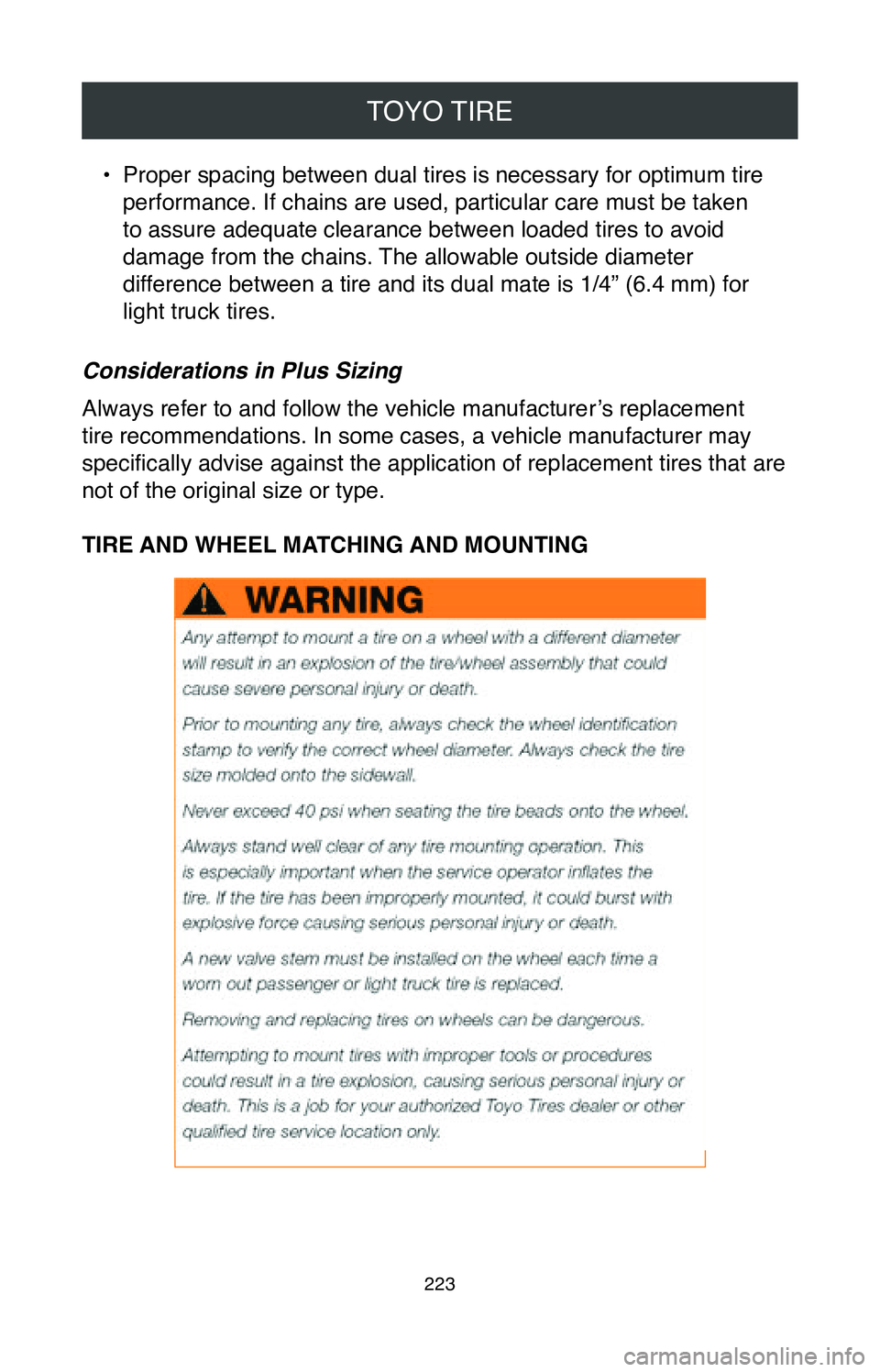
TOYO TIRE
223
• Proper spacing between dual tires is necessary for optimum tire
performance. If chains are used, particular care must be taken
to assure adequate clearance between loaded tires to avoid
damage from the chains. The allowable outside diameter
difference between a tire and its dual mate is 1/4” (6.4 mm) for
light truck tires.
Considerations in Plus Sizing
Always refer to and follow the vehicle manufacturer’s replacement
tire recommendations. In some cases, a vehicle manufacturer may
specifically advise against the application of replacement tires that are
not of the original size or type.
TIRE AND WHEEL MATCHING AND MOUNTING
Page 227 of 260
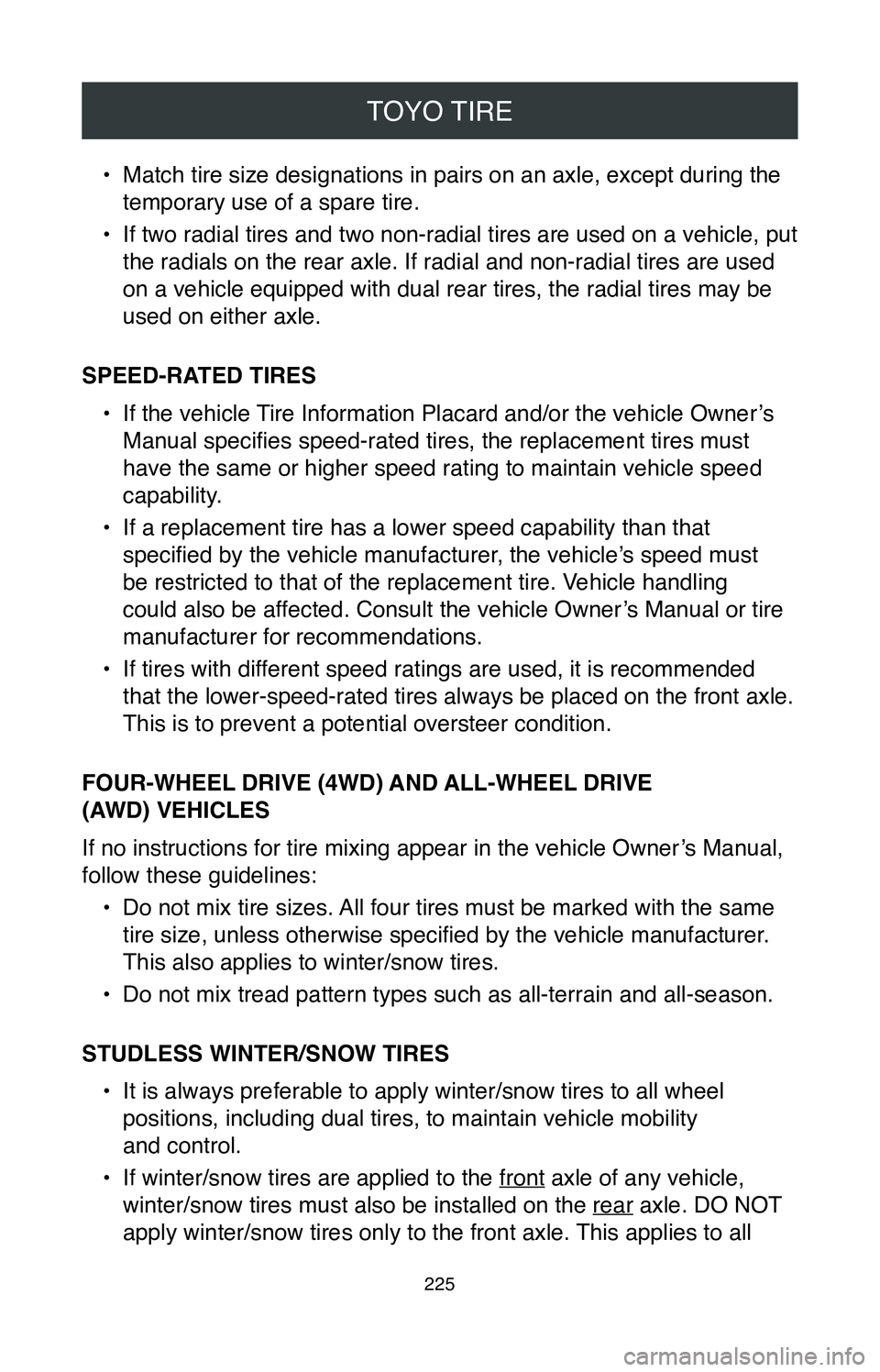
TOYO TIRE
225
• Match tire size designations in pairs on an axle, except during the
temporary use of a spare tire.
•
If two radial tires and two non-radial tires are used on a vehicle, put
the radials on the rear axle. If radial and non-radial tires are used
on a vehicle equipped with dual rear tires, the radial tires may be
used on either axle.
SPEED-RATED TIRES •
If the vehicle Tire Information Placard and/or the vehicle Owner’s
Manual specifies speed-rated tires, the replacement tires must
have the same or higher speed rating to maintain vehicle speed
capability.
•
If a replacement tire has a lower speed capability than that
specified by the vehicle manufacturer, the vehicle’s speed must
be restricted to that of the replacement tire. Vehicle handling
could also be affected. Consult the vehicle Owner’s Manual or tire
manufacturer for recommendations.
•
If tires with different speed ratings are used, it is recommended
that the lower-speed-rated tires always be placed on the front axle.
This is to prevent a potential oversteer condition.
FOUR-WHEEL DRIVE (4WD) AND ALL-WHEEL DRIVE
(AWD) VEHICLES
If no instructions for tire mixing appear in the vehicle Owner’s Manual,
follow these guidelines: •
Do not mix tire sizes. All four tires must be marked with the same
tire size, unless otherwise specified by the vehicle manufacturer .
This also applies to winter/snow tires.
•
Do not mix tread pattern types such as all-terrain and all-season.
STUDLESS WINTER/SNOW TIRES •
It is always preferable to apply winter/snow tires to all wheel
positions, including dual tires, to maintain vehicle mobility
and control.
•
If winter/snow tires are applied to the front axle of any vehicle,
winter/snow tires must also be installed on the rear axle. DO NOT
apply winter/snow tires only to the front axle. This applies to all
Page 232 of 260
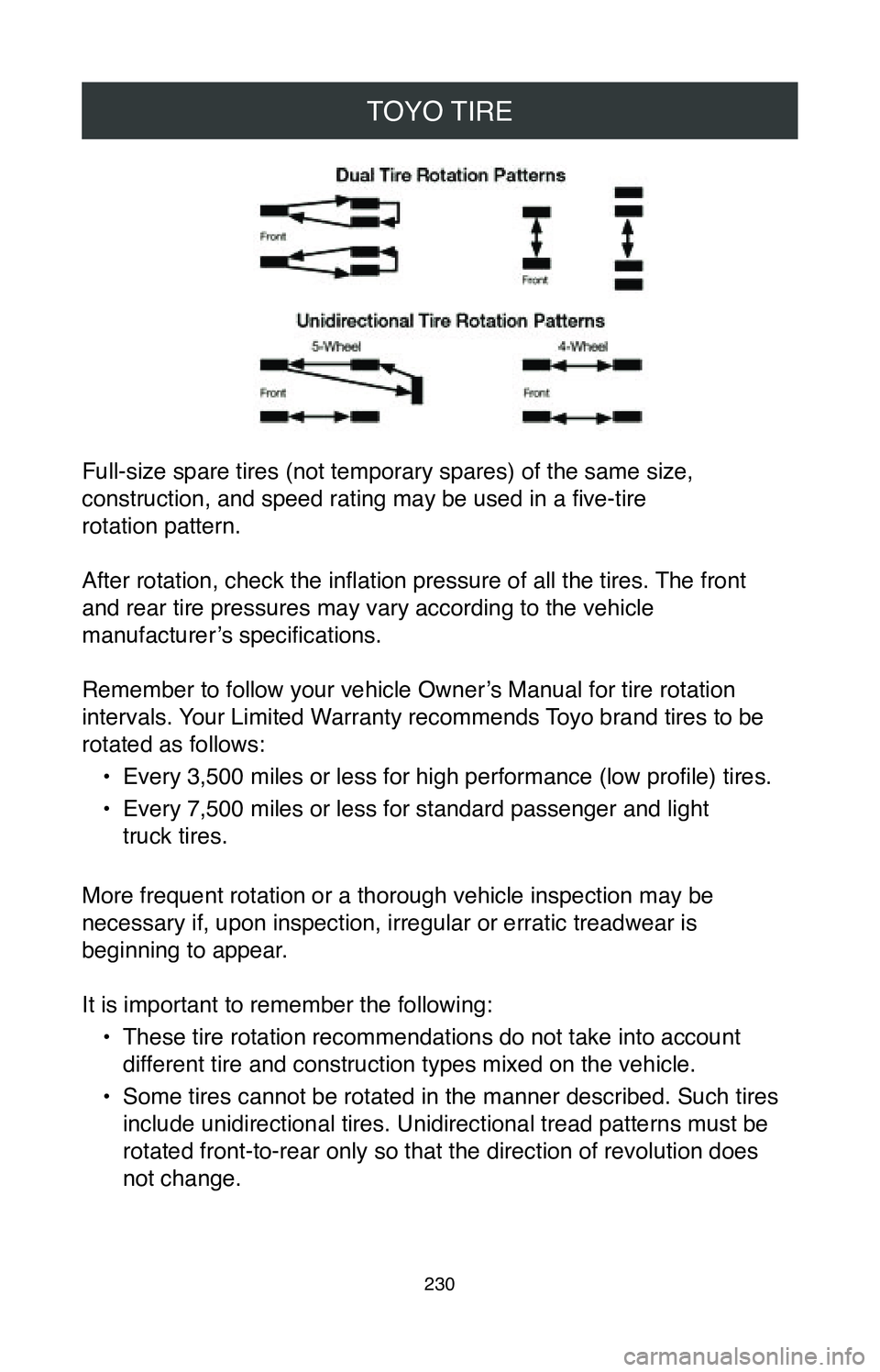
TOYO TIRE
230
Full-size spare tires (not temporary spares) of the same size,
construction, and speed rating may be used in a five-tire
rotation pattern.
After rotation, check the inflation pressure of all the tires. The front
and rear tire pressures may vary according to the vehicle
manufacturer’s specifications.
Remember to follow your vehicle Owner’s Manual for tire rotation
intervals. Your Limited Warranty recommends Toyo brand tires to be
rotated as follows:
•
Every 3,500 miles or less for high performance (low profile) tires.
•
Every 7,500 miles or less for standard passenger and light
truck tires.
More frequent rotation or a thorough vehicle inspection may be
necessary if, upon inspection, irregular or erratic treadwear is
beginning to appear.
It is important to remember the following: •
These tire rotation recommendations do not take into account
different tire and construction types mixed on the vehicle.
•
Some tires cannot be rotated in the manner described. Such tires
include unidirectional tires. Unidirectional tread patterns must be
rotated front-to-rear only so that the direction of revolution does
not change.
Page 233 of 260
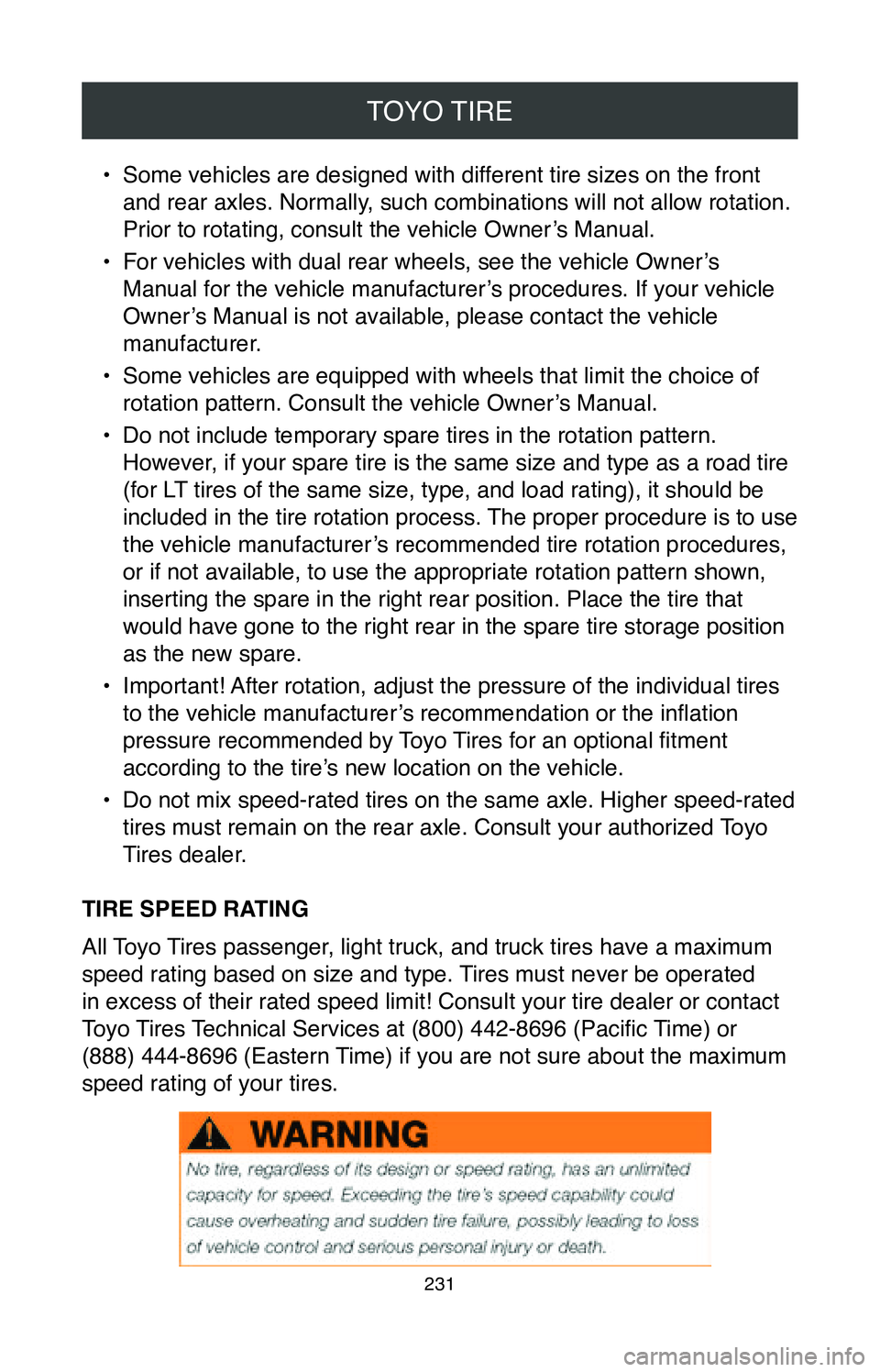
TOYO TIRE
231
• Some vehicles are designed with different tire sizes on the front
and rear axles. Normally, such combinations will not allow rotation.
Prior to rotating, consult the vehicle Owner’s Manual.
•
For vehicles with dual rear wheels, see the vehicle Owner’s
Manual for the vehicle manufacturer’s procedures. If your vehicle
Owner’s Manual is not available, please contact the vehicle
manufacturer.
•
Some vehicles are equipped with wheels that limit the choice of
rotation pattern. Consult the vehicle Owner’s Manual.
•
Do not include temporary spare tires in the rotation pattern.
However, if your spare tire is the same size and type as a road tire
(for LT tires of the same size, type, and load rating), it should be
included in the tire rotation process. The proper procedure is to use
the vehicle manufacturer’s recommended tire rotation procedures,
or if not available, to use the appropriate rotation pattern shown,
inserting the spare in the right rear position. Place the tire that
would have gone to the right rear in the spare tire storage position
as the new spare.
•
Important! After rotation, adjust the pressure of the individual tires
to the vehicle manufacturer’s recommendation or the inflation
pressure recommended by Toyo Tires for an optional fitment
according to the tire’s new location on the vehicle.
•
Do not mix speed-rated tires on the same axle. Higher speed-rated
tires must remain on the rear axle. Consult your authorized Toyo
Tires dealer.
TIRE SPEED RATING
All Toyo Tires passenger, light truck, and truck tires have a maximum
speed rating based on size and type. Tires must never be operated
in excess of their rated speed limit! Consult your tire dealer or contac\
t
Toyo Tires Technical Services at (800) 442-8696 (Pacific Time) or
(888) 444-8696 (Eastern Time) if you are not sure about the maximum
speed rating of your tires.
Page 238 of 260
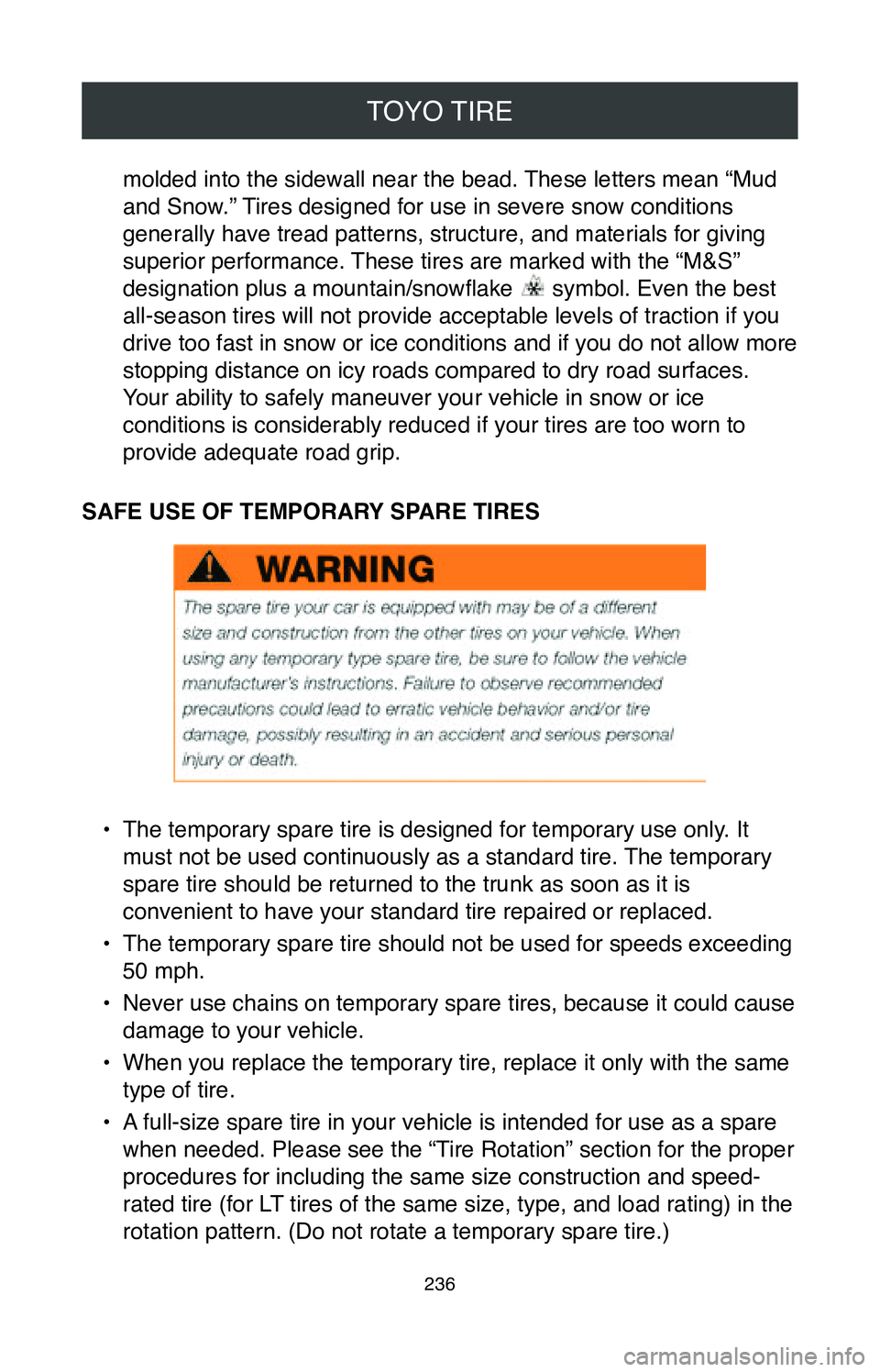
TOYO TIRE
236
molded into the sidewall near the bead. These letters mean “Mud
and Snow.” Tires designed for use in severe snow conditions
generally have tread patterns, structure, and materials for giving
superior performance. These tires are marked with the “M&S”
designation plus a mountain/snowflake
symbol. Even the best
all-season tires will not provide acceptable levels of traction if you
drive too fast in snow or ice conditions and if you do not allow more
stopping distance on icy roads compared to dry road surfaces.
Your ability to safely maneuver your vehicle in snow or ice
conditions is considerably reduced if your tires are too worn to
provide adequate road grip.
SAFE USE OF TEMPORARY SPARE TIRES
• The temporary spare tire is designed for temporary use only. It
must not be used continuously as a standard tire. The temporary
spare tire should be returned to the trunk as soon as it is
convenient to have your standard tire repaired or replaced.
•
The temporary spare tire should not be used for speeds exceeding
50 mph.
•
Never use chains on temporary spare tires, because it could cause
damage to your vehicle.
•
When you replace the temporary tire, replace it only with the same
type of tire.
•
A full-size spare tire in your vehicle is intended for use as a spare
when needed. Please see the “Tire Rotation” section for the proper
procedures for including the same size construction and speed-
rated tire (for LT tires of the same size, type, and load rating) in the
rotation pattern. (Do not rotate a temporary spare tire.)
Page 242 of 260
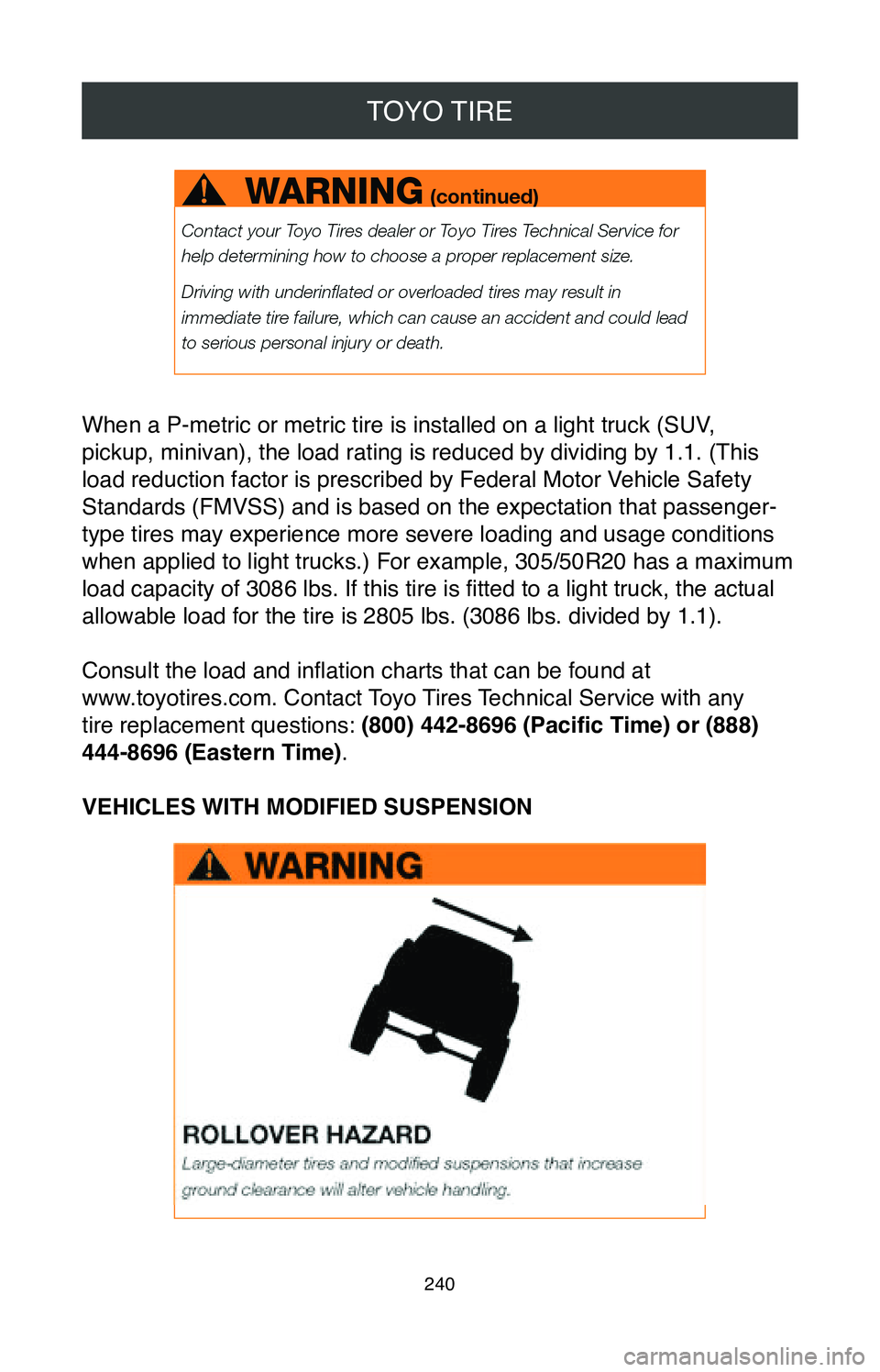
TOYO TIRE
240
When a P-metric or metric tire is installed on a light truck (SUV,
pickup, minivan), the load rating is reduced by dividing by 1.1. (This
load reduction factor is prescribed by Federal Motor Vehicle Safety
Standards (FMVSS) and is based on the expectation that passenger-
type tires may experience more severe loading and usage conditions
when applied to light trucks.) For example, 305/50R20 has a maximum
load capacity of 3086 lbs. If this tire is fitted to a light truck, the actual
allowable load for the tire is 2805 lbs. (3086 lbs. divided by 1.1).
Consult the load and inflation charts that can be found at
www.toyotires.com. Contact Toyo Tires Technical Service with any
tire replacement questions: (800) 442
-8696 (Pacific Time) or (888)
444
-8696 (Eastern Time).
VEHICLES WITH MODIFIED SUSPENSION